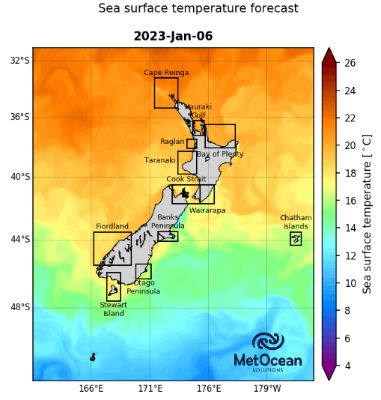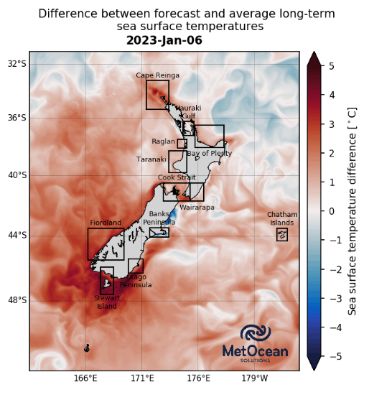New Year Brings Severe Marine Heatwave To Southern NZ
Although the early new year is set to bring rain to many areas, severe marine heatwaves are forecast for the bottom of the South Island where sea surface temperatures will reach a whopping 4 degrees or more above average. This is according to MetService oceanographer Dr Joao de Souza, who is tracking marine heatwaves as part of the Moana Project.
Dr Souza explains, “Sea surface temperatures are rising rapidly at the moment along the West Coast of the South Island, in Fiordland, around Stewart Island and towards the Otago Peninsula. The marine heatwaves we’ve seen building since before Christmas are expected to reach a new high Wednesday, with coastal patches off the West Coast forecast to reach 4.7 degrees above average for this time of year. Fiordland will also experience high water temperatures around this time, and around Stewart Island extending towards the Otago Peninsula we’re expecting a ‘severe’ marine heatwave later on in the week, on 5-6 January. Then, surface temperatures are forecast to reach 18.4 degrees, compared to the 13.5 degree average – a difference of almost 5 degrees.”
This will be good news for holiday makers, who will enjoy the balmy sea temperatures. However, the warm ocean temperatures sometimes cause more rainfall on land. “A warmer sea heats the air travelling over it and because warmer air can mean more moisture, we can get more rain,” adds Dr Souza.
He also cautions that persistent marine heatwaves may cause problems for marine life.
“Abnormally warm sea temperatures can potentially harm marine life,” continues Dr Souza. “Last year, a similarly warm marine heatwave in Fiordland reached great depths and caused widespread bleaching of sea sponges, and recent West Coast kelp disappearance has also been attributed to marine heatwaves.”
The 7-day forecasted sea surface temperatures and how they differ from the 25-year average (called the temperature anomaly) for New Zealand’s ocean can be explored on SwellMap, the free MetService marine forecasting website. Users can zoom in to areas of interest and click on the map to get the exact temperature or difference from normal.
The MetService-led Moana Project (https://www.moanaproject.org/) is a research project funded by the Ministry Business Innovation and Employment. The project aims to improve ocean observation and forecasting, including of marine heatwaves.




 Gordon Campbell: On Iran Killing Its Rappers, And Searching For The Invisible Dr. Reti
Gordon Campbell: On Iran Killing Its Rappers, And Searching For The Invisible Dr. Reti Government: Saves Access To Medicines
Government: Saves Access To Medicines Office of the Speaker: Law And Order, Finance, And Defence A Focus For Ukrainian Parliamentary Delegation To NZ
Office of the Speaker: Law And Order, Finance, And Defence A Focus For Ukrainian Parliamentary Delegation To NZ Environmental Defence Society: Fast-track Approvals Bill Presents A Serious Risk To New Zealand Exporters
Environmental Defence Society: Fast-track Approvals Bill Presents A Serious Risk To New Zealand Exporters NZ Government: New Lab To Help Protect Key Pacific Tuna Fisheries
NZ Government: New Lab To Help Protect Key Pacific Tuna Fisheries Susan Botting - Local Democracy Reporter: Ruawai Leader Slams Kaipara Council In Battle Over $400k Property
Susan Botting - Local Democracy Reporter: Ruawai Leader Slams Kaipara Council In Battle Over $400k Property Te Pati Maori: Another ‘Stolen Generation’ Enabled By Court Ruling On Waitangi Tribunal Summons
Te Pati Maori: Another ‘Stolen Generation’ Enabled By Court Ruling On Waitangi Tribunal Summons


